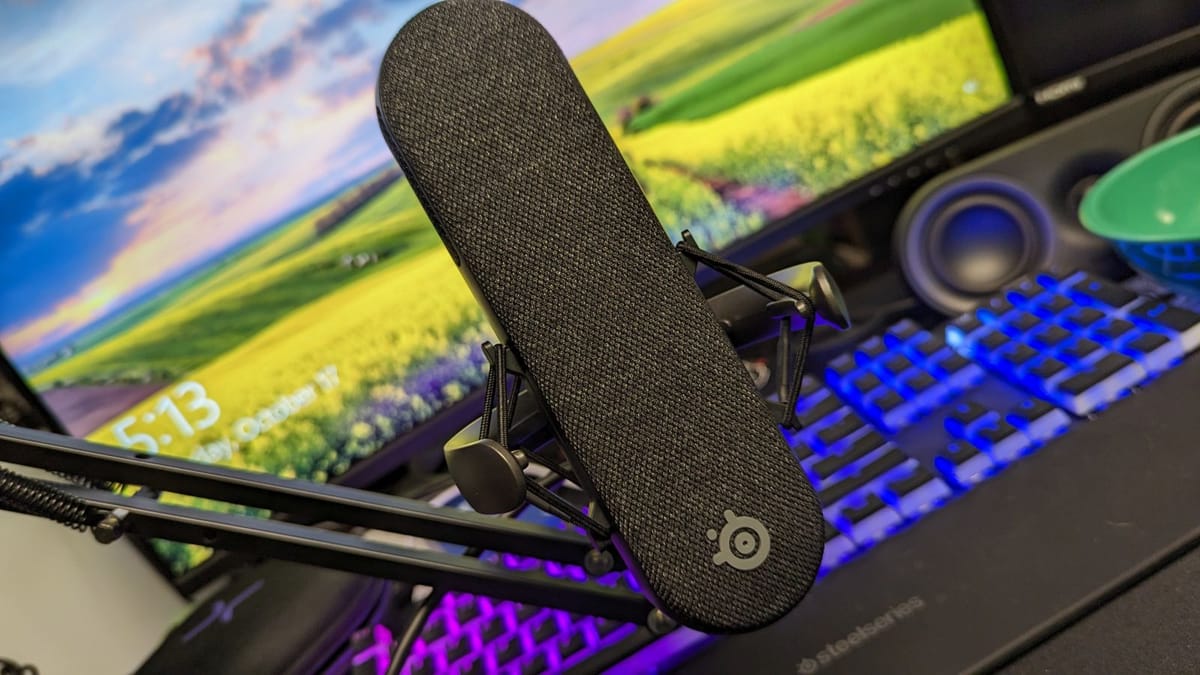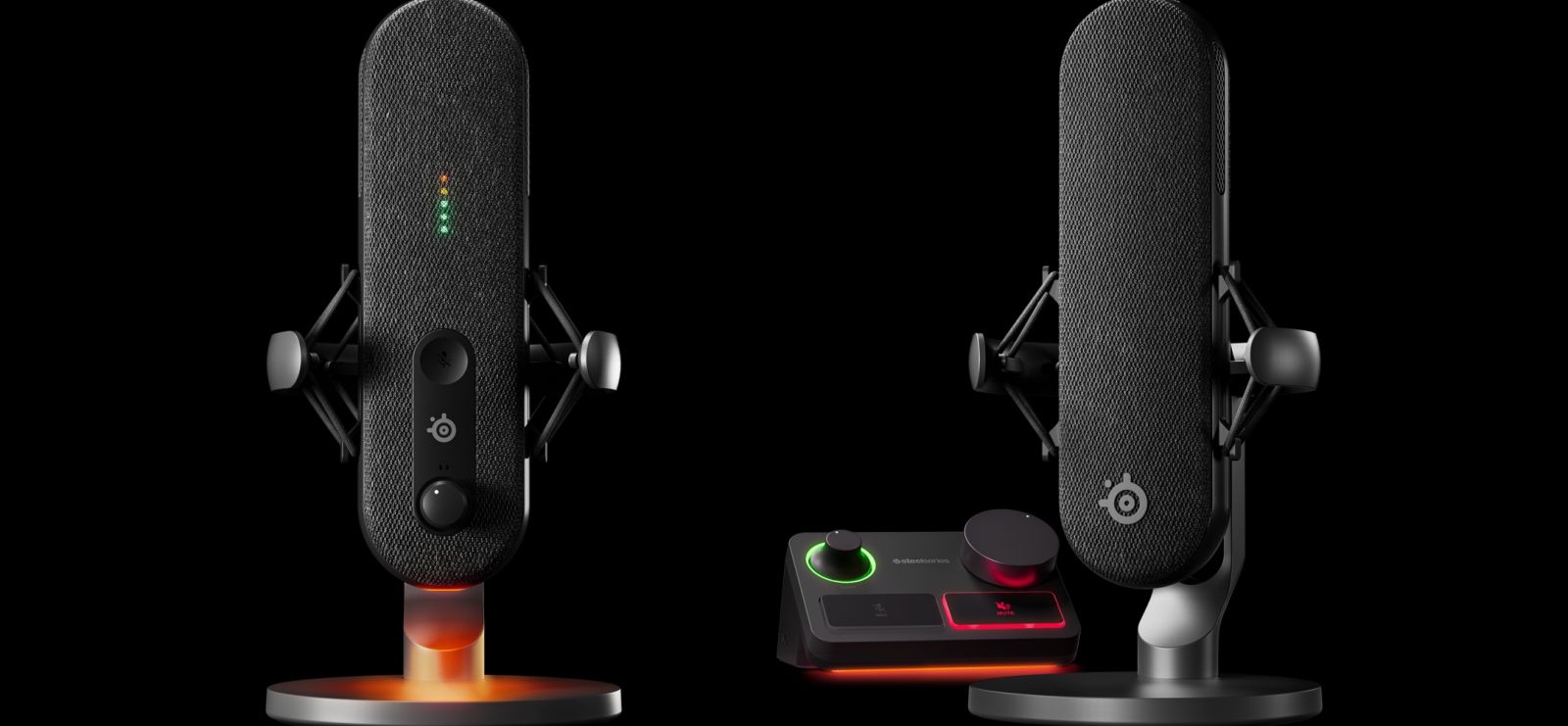
You all know, I’m a SteelSeries fiend. As I mentioned in our preview, my desk is taken over with their products, mainly because they’re all quality. With the SteelSeries Alias and Alias Pro releasing, it was time to switch out my Elgato Wave:3. That said, the Wave:3 is certainly the best mic I’ve ever used. Is SteelSeries answer worthy to replace it, or should I press the undo button?
To start, we head to the box. Inside the Alias package you’ll find the streaming mic on the stand, a USB-C cable for connecting it to your PC, and a boom arm adapter. Similarly with the Alias Pro, you’ll find the mic and stand, but also an XLR cable, stream mixer, power cable, and two USB-C cables. I also really appreciate the presence of a boom arm adapter in both boxes, allowing you to switch things up without needing to hunt for an adapter piece. My only qualm here is you might need an adapter if your current boom arm has a smaller thread to attach it to, so keep that in mind.
The Alias and Alias Pro mics themselves are sights to behold. SteelSeries has always had a really fantastic aesthetic, and it extends to these mics. They almost have an “old time radio” look to them, with a combination of fabric and plastic housing and some metal mesh. While the Alias Pro doesn’t feature any buttons given its XLR and mixer features, the Alias does.
There’s a volume knob for connected headphones (for mic monitoring) on front, along with a touch button for muting. That mute button rocks by the way, with only a light tap needed for activation, and muting at the press to keep from even the noise of pressing it. On the back is a gain knob, where your USB-C connects to PC, and the 3.5mm jack for aforementioned headphones. I think my only change here might have been swapping the knobs, so gain would be available more quickly.
On the Alias Pro, there’s only the connection to your stream mixer via the XLR cable. The mixer itself is compact and easy to set up even with plenty of things to attach, with clearly denoted ports on the back. There is an XLR port, an AC adapter connection, and two USB-C ports along with the 3.5mm jack for your headphones next to the power button. Heads up, to keep from damaging anything, make sure to connect your XLR cable FIRST before plugging in the AC adapter and turning it on.
On the front, it’s again very simple. There’s a gain knob on the top left, a customizable knob on the top right, and two mute buttons below. An extra benefit, the right mute button you have for your headphones can be customized as well, giving you extra control over your microphone.
Both the Alias and Alias Pro come attached to a heavy duty shock mount, made of metal and the mic held in place by elastic, braided bands. I love the choice, keeping your mic from picking up the vibrations from typing, or with me, pounding on my desk in anger after losing a match. They’re also both easy to detach and move to your boom arm, which is my usual worry when swapping things out. Given my propensity to lose pieces, having the boom adapter attached via the same key screw that bolts it to the desk stand makes me happy.
Of course, no piece of gear is complete without RGB, and the choices SteelSeries has brought to the Alias and Alias Pro are awesome. This isn’t just in form, but in function. For the Alias, the pretty RGB lies in a nice ring on the very bottom, but it’s more than that. There is an LED monitoring system built on the front of the mic, shining through the fabric. This shows you the peak of your voice, keeping you from being too loud without drawing your eyes away. Muting is also very obvious, with a big red X plastered on the face of the Alias. I don’t always use the “it just works” phrase, but here it just works.
As for the Alias Pro, the stream mixer contains all of your RGB. I would like a little on the mic, but given it’s more professional quality, I get the choice. On the stream mixer there’s a bar underneath at the front you can customize, and you’ll also get specific lighting for the functions, like the ring around the gain knob blinking green, yellow, and red for audio peaks. The mute buttons are defaulted to red, but you can even customize those to your liking.
All of these features and functions sound great, but sounding great is most important in your audio capture. SteelSeries has employed a “bigger is better” idea here, going with one of the biggest condenser capsules (1” in both) inside the Alias devices to grab the most of your voice. This is to get as much as possible, highs, mids, and lows. The other part of this is SteelSeries’ choice of a cardioid pattern of capture as opposed to the 4-in-1 some mics use. If you’re a streamer, none of the other options probably matter, so it’s better for this mic to do this specific thing the best.
With the Alias Pro, you also have your connection through XLR, which stands for eXternal Line Return. This runs your mic through the stream mixer, which also has a preamp built into it. I’ve always heard about XLR mics, and even that some people swear by them. Until now, I’ve not seen much of a difference, but for a streamer, especially using a dual PC setup, this makes a huge difference. We’ll talk about why in a moment, but the extra functionality is a nice perk.
It’s very evident in use that what’s being captured sounds fantastic. Even with no filters or EQ present, you’re getting some killer audio input. I’m no expert in terms of audio fidelity, but beyond tuning my gain to the correct levels, most of my adjustments have been uncomplicated.
Just listen to my audio below for the Marvel’s Spider-Man 2 review. I’m no sound engineer, and most of this was done with minimal tweaking of the EQ settings and my gain. I have to outline how easy SteelSeries has made audio for people who aren’t familiar with the product. Gone are the days of post-processing, you can have the best audio input right out of the box.
Getting the most out of any product you’re spending money on is always the goal, and that’s where Sonar comes into the picture. I’ve already spoken on how phenomenal the software from SteelSeries is in regards to audio output, but it’s also great for audio input. Sonar can be used for any of your devices, whether for SteelSeries or not. That said, it’s going to work the best for SteelSeries gear, just because it’s built with them in mind.
With the Alias and Alias Pro, the features available give you top-end tools to get not only the most out of your mic, but the most out of your stream. Starting with the basics, in your mic mixer you’ll find an EQ with twelve presets. Right off the bat you can adjust the mic to your voice, helping those like me who aren’t savvy with an EQ. There’s also noise reduction, a noise gate, and compressor for those who want to fine tune their audio a bit further.
There’s also ClearCast AI noise cancellation, which is a dumbfounding technological breakthrough from SteelSeries. I’ve spoken on how the Nova Pro’s noise canceling is top-notch, but the microphone’s is astounding. You can find people with videos next to cars rumbling and even outside on a rooftop with the city noises in the background, and the second they turn it on there’s simply nothing beyond their voice. It really works; in every situation I’ve used it, ClearCast is the perfect noise cancellation software.
When you turn on the Sonar for Streamers toggle, the magic extends even farther. Here you can manage ALL of your audio, whether stream music, Discord chat, your mic, or the game or video you’re watching. All of this is available from the digital studio mixer, allowing you to choose the balance of audio you want in your stream.
What’s better, there are multiple mastered mixes to work with. There’s a personal one: essentially what you’re hearing. Then, there’s a stream mix. This is what your audience hears.
Why this is important lies in connecting to your streaming software. With Sonar, all of the management of your multiple inputs feeds into one output, which can be plugged into, say, OBS, and you’re done. Gone is the multi-channel mixing from multiple sources, and here is a plug and play solution.
This is even more of a big deal when it comes to dual PCs. The Alias Pro can be connected to both via the two USB-C ports on the stream mixer. It’s as easy as these default instructions-
PERSONAL MIX
SteelSeries Alias Pro Personal (SteelSeries Alias Pro 1)STREAM MIX
SteelSeries Alias Pro Stream (SteelSeries Alias Pro 1)MIC INPUT
SteelSeries Alias Pro Input (SteelSeries Alias Pro 1)On your second PC (Windows only):
OUTPUT
SteelSeries Alias Pro Output (SteelSeries Alias Pro 2)INPUT (OBS or other broadcasting software)
SteelSeries Alias Pro Stream (SteelSeries Alias Pro 2)
Boom, it’s as simple as that. I keep using the words easy and simple in this review, and that’s because SteelSeries has made life easier for those of us who aren’t as familiar with this world.
To finish, let’s talk about the pricing. SteelSeries Alias starts at $179.99, with the Alias Pro at $329.99. That’s a lot of coin. When you compare that to the field, SteelSeries exists similarly in the space to its other devices; it’s not the cheapest, but not the most expensive. While I’d still rank my Elgato Wave:3 as better for the cost in terms of only the microphone, the Alias is a 1B option rather than a big drop off. For XLR microphones, the Alias Pro is worth the minor additional cost. It has too much upside and ease of use to pass up.
You can pick up the SteelSeries Alias and Alias Pro now! These are available at brick and mortar locations like Best Buy, and also online storefronts. Click this link to grab the Alias, and this one for the Alias Pro.
SteelSeries Alias
Excellent
Making streaming simpler, giving you the ability to utilize a great device no matter your setup, and assisting those who are just beginning to achieve the best, is a great accomplishment for any brand. SteelSeries has done just that with the Alias and Alias Pro streaming mics, with a delightful mic with good sound that can be what you need it to be. If you’re just starting out, you’ll get great audio. If you’re a pro, you’ll be able to tweak it to your liking and possibly get even more out of it. In any case, SteelSeries offers quality.
Pros
- Pleasing design
- Plug and play ease of use
- Excellent audio capture
- Terrific controls via face buttons and stream mixer
- Sonar in general and for Streamers is the best EQ and mixer software known to man
Cons
- A bit pricey
- Gain/volume knob swap on Alias


